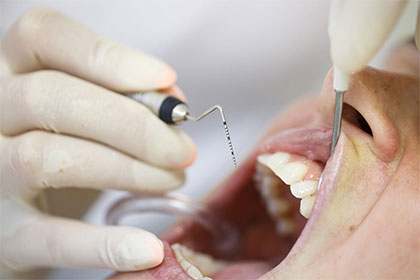What Is Gum Disease?
Gum disease, also known as periodontal disease, is a bacterial infection that affects your gums. If your gums are swollen or bleed easily, it is possible that you might have gum disease as these are the early signs. Having bad breath, which is usually a result from the blood and lack of oral hygiene, is also another early sign.

Gingivitis vs. Periodontitis: The Stages of Gum Disease
The early stage of gum disease is called gingivitis, and if left untreated, it may progress into the later stage called periodontitis. At this stage, your teeth will become rather loose and form gum pockets, which are the spaces between the gums and teeth. Bacteria could easily get stuck in these pockets, resulting in further damage to your dental health. Therefore, it is important to treat gum disease as early as possible.
What Are the Causes of Gum Disease?
There are several factors that could cause gum disease, including:
- Poor oral hygiene: The bacteria in your teeth will not be properly removed with the lack of oral hygiene.
- Hormones: Due to the hormonal changes that affect the sensitivity of the mouth, those experiencing menopause, pregnancy, puberty, and menstruation may experience gum disease.
- Genes: Gum disease is a hereditary condition, meaning that those with a gum disease background have higher chances of getting this disease.
- Health conditions: There are some illnesses that contribute to the appearance of gum disease, including HIV, cancer, diabetes, rheumatoid arthritis, and scurvy. Because these diseases have negative impacts on the immune system and the overall nutritional balance, the body becomes more vulnerable to gum disease.
- Medications: Some medicines make the mouth dry, and this interferes with the flow of saliva that helps protect the teeth.
- Tobacco consumption: Consumption of tobacco, whether it is from smoking or chewing, may cause gum disease. Tobacco reduces the strength of your immune system, which makes it easier for gum disease to appear and harder for it to heal.
What Are the Risks and Possible Complications of Having A Gum Disease?
The receding gums and increasing gum pockets caused by gum disease may lead to tooth loss. Additionally, some researchers have suggested that gum disease may also increase the possibilities of serious health issues, including diabetes, lung disease, heart disease, and premature birth.
Gum Disease Treatments and Why You Might Need Them
To avoid the risks and complications of having a gum disease, getting a proper treatment is a wise decision and a good step for better health. There are several treatments available to repair your gums, varying based on the levels of severity that each suit most.
How Do Gum Disease Treatments Work?
Firstly, your dentist will perform a dental exam, checking the gums’ firmness and condition, size and depth of gum pockets, teeth alignment, and jawbones. They will also conduct a dental hygiene evaluation to see if your oral hygiene has been adequate.
Next, your dentist will determine the most suitable treatment depending on the severity of your condition. Here are some of the treatments that can be done:
- Scaling: This is a non-surgical treatment to cure gum disease. The dentist will professionally remove dental plaque and tartar (the yellow or brown deposit on the lower part of your teeth) by using dental tools. Sometimes it takes more than one session to complete the scaling process, and when the condition is more serious, root planing is needed.
- Root planing: Similar to scaling, root planing is a non-surgical method to heal gum disease as well. While scaling focuses on deep cleaning the teeth, root planing aims to cleanse the area underneath your gums, including the roots of teeth. Local anaesthetic, which will make your gums numb, may be required for this process.
- Bone graft: Bone grafting is a surgical procedure that is needed when your teeth have been seriously affected. The dentist will take a sample of your bone from a different area of your body and then graft it onto your bone. This method is designed to strengthen jawbones and teeth that have been seriously affected by gum disease.
- Soft tissue graft: In cases where the gums have greatly receded, this method is used to strengthen the gums. A tissue sample will be taken from the roof of your mouth and then carefully stitched onto the affected area.
- Gum contouring: This procedure is required when your gum line had become uneven due to gum recession, making it easier for bacterias to get trapped. The goal of gum contouring is to help even out the gum line and restore proper protection for the teeth. The dentist will give you a local anaesthetic to numb the gums before removing excess gum tissues using soft tissue laser.
Gum Disease Aftercare Instructions
After the treatment, your dentist will prescribe certain medications that need to be taken to lessen the swelling and discomfort.
You are also only allowed to consume soft food and food that cannot be easily stuck in teeth, avoid hot and cold food and beverages, avoid spicy and acidic food, chew carefully on the side that is not affected by the treatment, and you are not allowed to smoke and consume alcohol for 2-14 days after the treatment. The use of straw is also prohibited as the suction will interfere with the healing process.
Additionally, you will be required to rinse your mouth using salt water 2-3 times daily to reduce the inflammation. If you experience any major discomfort or swelling, contact your dentist immediately.
Moreover, it is important to maintain good oral hygiene after your gum disease has been treated. Remember to brush your teeth twice a day, floss, and use mouthwash regularly to prevent gum disease from happening again.

